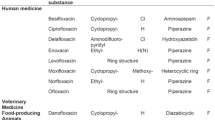Abstract
The influence of sarafloxacin (SAR) hapten orientation in immunogen on antibody specificity was examined. The spatial orientation of SAR linked through its carboxyl group to the carrier resulted to SAR-selective response (Anal Methods 2016, 8:5843–5850). To provide opposite orientation of SAR in immunogen, it was linked by its secondary amine to (1) succinic anhydride-modified BSA using carbodiimide-mediated conjugation and to (2) unmodified BSA using formaldehyde condensation method. Two versions of indirect competitive enzyme-linked immunosorbent assays (ELISA) based on generated antibodies were developed. A panel of homo- and heterologous conjugates was examined as potential coating antigens. No cross-reactions were registered in ELISA-1 and ELISA-2 except for fluorophenyl-containing fluoroquinolones difloxacin (DIF), SAR, and tosufloxacin as 138, 100 and 25% and 175, 100 and 8%, respectively. Among the recognized analytes, only DIF is authorized in meat products, so the developed tests were selective for DIF determination in bovine and porcine muscles and sera samples. The values of half-maximal inhibition concentration (IC50) for these assay versions were estimated to be 1.2 and 0.25 ng/ml. DIF detection limits (IC10) were, respectively, 0.15 and 0.015 ng/ml that allowed measuring of MRL and ten times lower level of DIF in the animal muscles. The developed ELISAs were also suitable for DIF determination in animal sera in the concentration range 1000–1 ng/ml.





Similar content being viewed by others
References
Bucknall S, Silverlight J, Coldham N, Thorne L, Jackman R (2003) Antibodies to the quinolones and fluoroquinolones for the development of generic and specific immunoassays for detection of these residues in animal products. Food Addit Contam 20(3):221–228
Burkin M (2008) Enzyme-linked immunosorbent assays of fluoroquinolones with selective and group specificities. Food Agric Immunol 19(2):131–140
Burkin AA, Burkin MA (2008) Obtaining antibodies to 1,4-dihydropyridine calcium channel antagonists. Appl Biochem Microbiol 44(3):323–327
Burkin M, Galvidis I (2013) Immunochemical detection of apramycin as a contaminant in tissues of edible animals. Food Control 34:408–413
Burkin MA, Galvidis IA (2016) Simultaneous and differential determination of drugs and metabolites using the same antibody: difloxacin and sarafloxacin case. Anal Methods 8:5843–5850
Cao L, Kong D, Sui J, Jiang T, Li Z, Ma L, Lin H (2009) Broad-specific antibodies for a generic immunoassay of quinolone: development of a molecular model for selection of haptens based on molecular field-overlapping. Anal Chem 81(9):3246–3251
Chen J, Jiang J (2013) Monoclonal antibody-based solvent tolerable indirect competitive ELISA for monitoring ciprofloxacin residue in poultry samples. Food Agric Immunol 24(3):331–344
Cui J, Zhang K, Huang Q, Yu Y, Peng X (2011) An indirect competitive enzyme-linked immunosorbent assay for determination of norfloxacin in waters using a specific polyclonal antibody. Anal Chim Acta 688:84–89
Deng SL, Li P, Liu HB, Yang SM (2014) Preparation and characterization of ultrasensitive and specific polyclonal antiserum against ciprofloxacin based on cationized bovine serum albumin. Chem Pap 68(11):1505–1513
EU Council Regulation (2010) N 37/2010 of 22 December 2009 on pharmacologically active substances and their classification regarding maximum residue limits in foodstuffs of animal origin. Official Journal of European Union L15:1–72
European Centre for Disease Prevention and Control, European Food Safety Authority and European Medicines Agency (2015) ECDC/EFSA/EMA first joint report on the integrated analysis of the consumption of antimicrobial agents and occurrence of antimicrobial resistance in bacteria from humans and food-producing animals. European Food Safety Authority EFSA Journal 13(1):4006 114 pp
Franek M, Zeravik J, Eremin SA, Yakovleva J, Badea M, Danet A, Nistor C, Ocio N, Emneus J (2001) Antibody based methods for surfactant screening. J Fresenius Anal Chem 371:456–466
Hermanson GT (2008) Bioconjugate techniques. Academic Press, London, p. 1323
Huet A, Charlier C, Tittlemier S, Singh G, Benrejeb S, Delahaut P (2006) Simultaneous determination of (fluoro)quinolone antibiotics in kidney, marine products, eggs, and muscle by enzyme-linked immunosorbent assay (ELISA). J Agric Food Chem 54:2822–2827
Jinqing J, Haitang Z, Ziliang W (2011) Development of an immunoassay for determination of fluoroquinolones pollutant in environmental water samples. Energy Procedia 11:2756–2761
Li Y, Ji B, Chen W, Liu L, Xu C, Peng C, Wang L (2008) Production of new class-specific polyclonal antibody for determination of fluoroquinolones antibiotics by indirect competitive ELISA. Food Agric Immunol 19(4):251–264
Liu YZ, Zhao GX, Wang P, Liu J, Zhang HC, Wang JP (2013) Production of the broad specific monoclonal antibody against sarafloxacin for rapid immunoscreening of 12 fluoroquinolones in meat. J Environ Sci Health B 48(2):139–146
Sanitary Regulation (2010) SanPiN 2.3.2.1078–01 Hygienic Requirements for Safety and Nutritive Value of Foodstuffs, Moscow, 2008. (In Russian), Supplement 22
Sheng W, Xia X, Wei K, Li J, Li QX, Xu T (2009) Determination of marbofloxacin residues in beef and pork with an enzyme-linked immunosorbent assay. J Agric Food Chem 57:5971–5975
Wang Z, Zhang H, Ni H, Zhang S, Shen J (2014) Development of a highly sensitive and specific immunoassay for enrofloxacin based on heterologous coating haptens. Anal Chim Acta 820:152–158
Zhao C, Liu W, Ling H, Lu S, Zhang Y, Liu J, Xi R (2007) Preparation of anti-gatifloxacin antibody and development of an indirect competitive enzyme-linked immunosorbent assay for the detection of gatifloxacin residue in milk. J Agric Food Chem 55:6879–6884
Zhi A, Li B, Liu Q, Hu X, Zhao D, Hou Y, Deng R, Chai S, Zhang G (2010) Development of a lateral-flow immunochromatographic test device for the rapid detection of difloxacin residues. Food Agric Immunol 21(4):335–345
Author information
Authors and Affiliations
Corresponding author
Ethics declarations
Conflict of Interest
Inna Galvidis declares that she has no conflict of interest. Maksim Burkin declares that he has no conflict of interest.
Ethical Approval
This article does not contain any studies with human participants performed by any of the authors. All studies with experimental animals were carried out under the guidelines of Ethics Committee of I. Mechnikov Research Institute of Vaccines and Sera.
Informed Consent
Not applicable.
Rights and permissions
About this article
Cite this article
Galvidis, I.A., Burkin, M.A. Selective Immunodetection of Difloxacin in Animal Muscles and Sera: Role of Hapten Orientation. Food Anal. Methods 10, 1755–1764 (2017). https://doi.org/10.1007/s12161-016-0730-0
Received:
Accepted:
Published:
Issue Date:
DOI: https://doi.org/10.1007/s12161-016-0730-0




